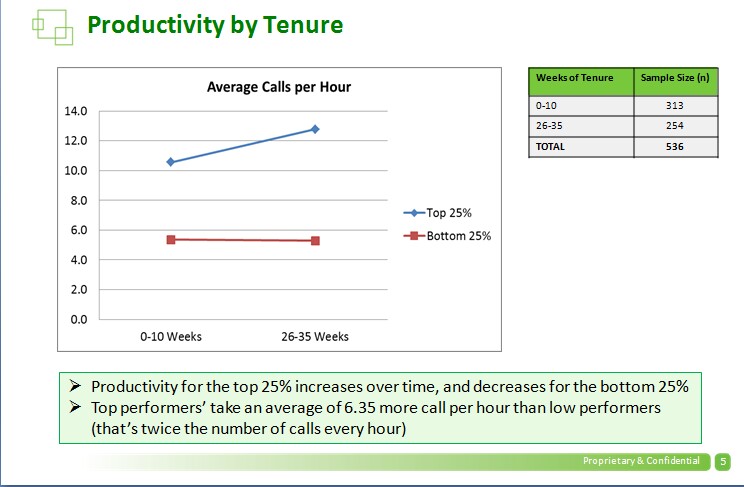Evolving Analytics (EvolvOnDemand)

Years ago, I was asked to take over an operation that had a bad retention problem. My own HR person couldn't crack the code on the causal factors behind it. Our firm's global HR group and our IT department weren't any help either. So, one weekend, I pulled the paper files on everyone who had ever worked in the group going back 17 years. My "analysis" included putting files into piles based on years they stayed with the firm. Then, I started to compare the attributes of the short-timers with the folks who stuck around. After testing many hypotheses, one of them finally stuck out: people with liberal arts bachelor degrees only stayed with the company about 1 year 11 months (+/- 1 month). That one data point was worth millions to my group as we could change the focus of our recruiting, save on training costs, increase margins, etc. This was HR analytics the old school way. Can't HR analytics technology do at least this????
Evolv On Demand is cool HR technology that warrants attention. Why? It's the sort of product that's really a BI tool that has been built out fully to support specific HR needs. What it isn't is just a bunch of analytic parts that users have to figure out how to use.
My biggest issue with most HR BI/Analytic applications is that they aren't applications at all. Someone took a good tool and did a simple 9-box depiction of pay rates versus performance rankings. With that one graphic, they declare it's an application and they're done! I don't think so.
Most of the newer HR analytic apps are simply displaying data already found in pre-existing HR portals or other HR reports. They contain traditional HR transaction data and occasionally correlate it to some other HR data. NO REAL INSIGHT comes from regurgitating the same transaction data over and over again. Yet, for the unimaginative HR software vendors out there, that's exactly how they play their bolt-on, poorly thought-through analytic apps.
Evolv did something few HR software vendors do - they took the time to understand what sort of problems a subset of employers routinely encounter but rarely can solve. They then took those problems and asked what sort of other information (i.e., non-HR data) would be needed to really understand these problems. This process is original research and it's what most software vendors, HR and other, have forgotten how to do.
Evolv has utilities to identify for example:
1) Why some groups of employees have different retention rates? Was it because some groups had a better trainer than another? Could it be the amount of time these people spent in the training?
2) What factors are driving increases or decreases in worker productivity?
3) What can be done to drive greater cross-selling of solutions by call center employees?
4) How can a business identify the characteristics that will predict which employees will become top performers?
The approach Evolv has taken means their solution is solving the challenges of companies that hire large numbers of workers initially. I say initially as a great analytics vendor has to pick out a couple of big problem areas or market segments and then develop the solutions for them. Afterwards, they can select more problem areas to solve. The real challenge of an analytics solutions provider is that they must:
- Study the managers and businesses they hope to help
- Develop hypotheses and hunches around each problem they witness
- Identify potential sources of information that could help shed light on the issue
- Find ways to display the results in a manner that quickly steers executives and others to the correct courses of action to take
The process above is straightforward but used too infrequently by some analytic solutions providers, especially those that peddle tools.
Evolv, for now, can best help firms like retailers, call center operators, fast food firms and others that hire large volumes of employees. Their current mix of analytic tools can improve hiring & training decisions. It gets data from HR, training, sales and other systems to determine which employee traits, which trainers, etc. are delivering the most value to the firm.
Evolv has also developed a number of assessment tools to help firms identify which applicants possess traits that should engender greater on the job success. The traits are uniquely matched to a given employer as some firms have (and want) greater concentrations of some traits over others. Your firm may value a call center employee that will go above and beyond to delight a customer. Another firm may value prospective employees that will do a great job of upselling customers to new/additional products. Each desired outcome drives a need for a different collection of traits. I'll leave it to Evolv to explain how they do this.
Evolv markets themselves as a ‘data-driven workforce selection' vendor. But I believe it is more than this. Last week, Evolv brought into their executive team a former Oracle executive as their new VP of Engineering. This executive's expertise is in predictive analytics. In a briefing I had with a different Evolv executive, it was apparent that the workforce selection capability they are marketing today is but an indicator of other capabilities to come.
Bottom line: I like the direction the company has in solving tough, thorny HR problems. I like the way they approach analytics and HR, especially their willingness to use non-HR data as part of their solutions. Finally, I look forward to new innovations from them and others in the HR analytics space because I really don't want to have to dig through 17 years of personnel records ever again.
